The Chipmunk's Tale: Seven Decades Long
Warbirds in Review
July 25, 2016 - The deHavilland Chipmunk is an inspired diminutive trainer that has 70 years of military and civilian service to celebrate at AirVenture 2016. In the ebb and flow of aircraft arrivals during AirVenture, a dozen of the trainers may be found in the Warbirds parking area. Probably 100 Chipmunks are in the United States today. Three Chipmunk fliers gathered to tell visitors about their airplanes at Monday morning’s Warbirds in Review session.
Richard Wilsher displayed his red-and-white former Royal Air Force Chipmunk that he flew to AirVenture from southern California through a blistering heat wave. “I love the plane, and I love getting out of it,” he joked with the crowd.
The genesis of the Chipmunk was the need for a more modern trainer to replace the open-cockpit biplane deHavilland Tiger Moth of World War II. The result was a stressed skin metal fuselage supported by a low cantilever wing that is part aluminum and part fabric covered. DeHavilland of Canada undertook production, as did the British deHavilland. Canadian Chipmunks often are recognized by their large blown bubble canopy; the stock British Chipmunk at AirVenture 2016 has a lower profile multi-paned cockpit enclosure. Sturdy wide-track fixed landing gear legs were designed with student pilots in mind. Wilsher said “It can take a pretty heavy bounce and not get too upset with you.”
Wartime stocks of air-cooled Gipsy Major engines from the Tiger Moth program, plus other Tiger Moth internal components, were frugally folded into the new Chipmunk design. The little trainer acquired some nicknames along the way, Wilsher said, including Tin Sardine, owing to its rounded metal fuselage, and The Poor Man’s Spitfire. Production in Canada, England, and Portugal came to just under 1,300 Chipmunks built, with the last six Portuguese machines made in 1960-61.
In the United Kingdom, four venerable Chipmunks soldier on with the military, Wilsher told the Warbirds in Review crowd. Two in the Royal Air Force still give early taildragger time to current military pilots who will operate vintage fighters in the Battle of Britain Memorial Flight. The British Navy and Army each keep a Chipmunk on the roster for similar purposes.
Mark Meredith brought a unique open-cockpit Super Chipmunk to AirVenture. Air show enthusiasts know about the modified Chipmunks the late Art Scholl flew beginning in the 1960s. With an uprated engine, Scholl applied a much larger angular fin and rudder that made his Chipmunks distinctive. Meredith’s 1951 British machine at AirVenture has a Scholl-esque tail to offset the IO-540 engine in the nose. Meredith said his Chipmunk had been an agricultural sprayer in Australia, with one seat replaced by a chemical hopper. Several owners later, Meredith undertook want he calls a five-year “re-imagination” of the Chipmunk, restoring and adding touches until he has a sleek aircraft that looks part air show, and all sporty. Wheel pants, molded windscreens, and that famous angular Tail silhouette complete the picture.

